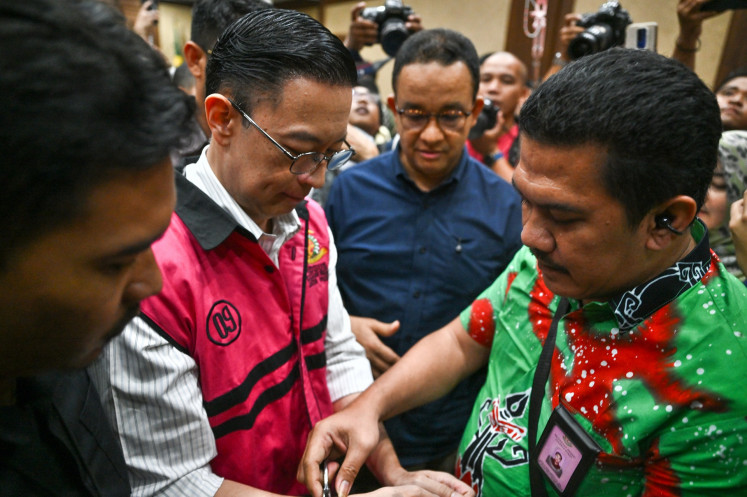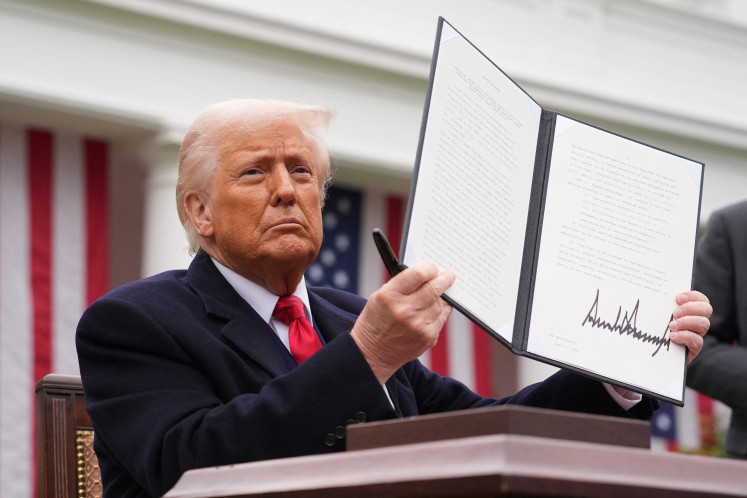Popular Reads
Top Results
Can't find what you're looking for?
View all search resultsPopular Reads
Top Results
Can't find what you're looking for?
View all search resultsProtection sought for Indonesia’s endangered endemic coral reefs
The rising rate of coral destruction in Indonesia has reached an alarming level, triggering many to start upping the ante in the protection of Indonesia’s native coral species
Change text size
Gift Premium Articles
to Anyone
T
he rising rate of coral destruction in Indonesia has reached an alarming level, triggering many to start upping the ante in the protection of Indonesia’s native coral species.
Indonesia is home to four endemic coral species that are lacking conservation protections, according to a report from the Indonesian Institute of Sciences (LIPI).
The absence of proper conservation efforts to safeguard the endemic species expose them to the risk of being destroyed due to disturbances such as irresponsible tourism and destructive fishing, the two major causes behind the global decline of coral reefs.
The four species are Isopora togianensis, found in Togean Islands in Central Sulawesi; Indophyllia macassarensi, discovered in waters off Makassar, South Sulawesi; Acropora suharsonoi, in Lombok in West Nusa Tenggara; and Euphyllia baliensis, found in the deep sea around Candidasa and Nusa Penida in Bali.
LIPI’s Oceanography Research Center senior researcher Suharsono, who oversaw the study, said the four species must be put under conservation because they were susceptible to extinction, especially given their already minuscule population.
Among the four species, only the habitat of the Acropora suharsonoi is within a recognized conservation area, namely the Gili Matra Marine Tourism Park, which spans the world famous Gili Trawangan, Gili Air and Gili Meno islands in northern Lombok.
But protections for the species, he said, were “somewhat ineffective” due to the presence of thousands of tourists who visit the area on a daily basis, especially Gili Trawangan island.
“We cannot wait until they are near extinction. They can easily disappear due to exploitation or pollution. We have to be aware of this danger,” Suharsono told The Jakarta Post on Thursday.
In total, 559 coral reef species, or 67 percent of the world’s coral reef collection, can be found in Indonesia, which houses numerous world-class scuba diving spots such as Raja Ampat in West Papua, Wakatobi in Southeast Sulawesi and Alor in East Nusa Tenggara.
But a combination of anthropogenic factors and climate change has put the future of Indonesia’s coral reef in jeopardy. LIPI’s recent study finds only 6.39 percent of the nation’s reef remain in an excellent condition.
According to the World Wildlife Fund (WWF), Indonesia’s endemic coral species are among 15 endemic coral species discovered in the Coral Triangle, the highest concentration of marine biodiversity found in the world. The triangle spans Indonesia, Timor Leste, Papua New Guinea, Malaysia, the Philippines and Solomon Islands.
The special character of the four species is driven by their unique habitats and interaction with long-term geological processes, which give them features that are different from their respective genus members.
The waters off Nusa Penida, for instance, have a strong current that possibly caused the euphyllia baliensis species to have a smaller size compared to other corals belonging to Euphyllia genus, which generally grow to be large in size.
“The baliensis has adapted to the strong Nusa Penida sea current, which arguably caused the species to have small polyps,” Suharsono said. The oddity of the four species also makes prone to illegal trading, he added.
With its glowing-red and green color and unique tentacle size, the solitary Indophyllia macassarensis is somewhat more attractive than its peers in the deep waters off Makassar, while the Acropora suharsonoi has attracted reef collectors recently for its plain-colored branches that are different from other corals in the genus.
The Maritime Affairs and Fisheries Affairs Ministry’s director for conservation and marine biodiversity, Andi Rusandi, whose agency manages marine conservation in Indonesia, echoed Suharsono’s view on the importance of conserving the country’s endemic coral species.










